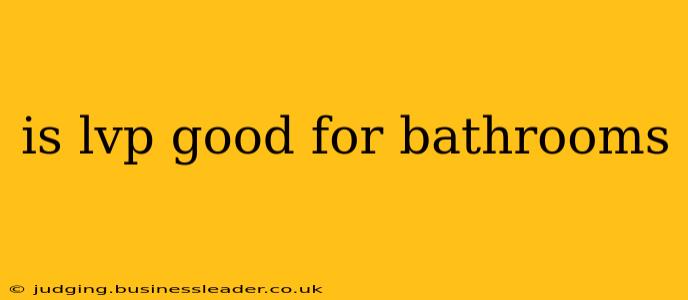Luxury vinyl plank (LVP) flooring has exploded in popularity, thanks to its durability, affordability, and stylish designs. But when it comes to bathrooms, a room notorious for moisture, the question remains: is LVP a good choice? The answer, as with most things, is nuanced. While not every LVP is bathroom-ready, many are, making it a viable – and often excellent – option for this high-traffic, high-moisture area of your home.
What Makes LVP Suitable (or Unsuitable) for Bathrooms?
The key to determining whether LVP is right for your bathroom lies in understanding the material's properties and choosing the right product. Let's explore the factors to consider:
Water Resistance vs. Waterproof:
This is the crucial distinction. Many LVP floors boast water resistance, meaning they can withstand spills and splashes for a limited time. However, prolonged exposure to water can damage these floors, causing warping, buckling, or even mold growth. True waterproof LVP, on the other hand, features a core construction designed to completely prevent water penetration. This is what you need for a bathroom environment. Look for LVP explicitly labeled as waterproof or 100% waterproof.
Core Material:
The core material significantly impacts water resistance. Waterproof LVP typically uses a core made of:
- Solid vinyl: A single layer of vinyl, offering excellent water resistance.
- Composite core (SPC or WPC): Stone Polymer Composite (SPC) and Wood Polymer Composite (WPC) cores combine vinyl with other materials (stone powder or wood flour) for enhanced durability and water resistance. SPC is generally harder and more rigid, while WPC is softer and more comfortable underfoot. Both are excellent choices for bathrooms.
Avoid LVP with a cheaper, less dense core, as these are more susceptible to water damage.
Wear Layer:
The wear layer is the topmost protective layer of the LVP. A thicker wear layer (typically 20 mils or more) offers better resistance to scratches, stains, and general wear and tear – vital in a bathroom where dropped items and cleaning solutions are common.
Will LVP Get Damaged in a Bathroom?
H2: How Much Water Damage Can LVP Withstand?
The amount of water damage LVP can withstand depends entirely on whether it is waterproof and the quality of the installation. Waterproof LVP, properly installed and sealed, can handle significant spills and even standing water for a period of time (though it's advisable to wipe up any excess moisture promptly). Water-resistant LVP, however, is not designed for prolonged water exposure and could suffer damage.
H2: Can LVP Get Moldy in a Bathroom?
Properly installed waterproof LVP shouldn't get moldy because water cannot penetrate the core. However, if the installation is flawed (e.g., inadequate sealing around the edges), or if it's a water-resistant and not waterproof LVP, moisture can seep beneath the planks creating a breeding ground for mold and mildew. Good ventilation in the bathroom is also essential in preventing mold growth, regardless of the flooring type.
H2: What Are the Pros and Cons of Using LVP in Bathrooms?
Pros:
- Water Resistance (if waterproof): The primary advantage is the superior water resistance of waterproof LVP.
- Durability: Resists scratches, dents, and everyday wear and tear.
- Affordability: Generally more affordable than other bathroom flooring options like ceramic tile or natural stone.
- Easy Installation: Can be installed as a DIY project, saving on labor costs.
- Variety of Styles: Available in a wide range of colors, patterns, and textures mimicking natural materials.
Cons:
- Potential for Damage (if not waterproof): Using non-waterproof LVP in a bathroom can lead to significant problems.
- Seamless Installation is Crucial: Improper installation can compromise the waterproofness and lead to damage.
- Can Feel Cold Underfoot: Unlike tile, LVP may feel colder in cooler climates.
Choosing and Installing LVP for Your Bathroom
Selecting the right LVP and ensuring professional installation are crucial for success. Always verify the flooring's waterproof rating and look for warranties specifically covering bathroom use. Properly sealed edges and a moisture barrier beneath the LVP are also vital. If you're unsure about DIY installation, it's best to hire a qualified flooring professional to ensure a long-lasting, damage-free installation.
In conclusion, LVP can be a fantastic option for bathrooms, providing a stylish, durable, and affordable flooring solution. However, selecting a truly waterproof LVP and ensuring proper installation are paramount to avoiding potential problems. Prioritizing these factors will help you enjoy your beautiful and functional LVP bathroom floor for years to come.
